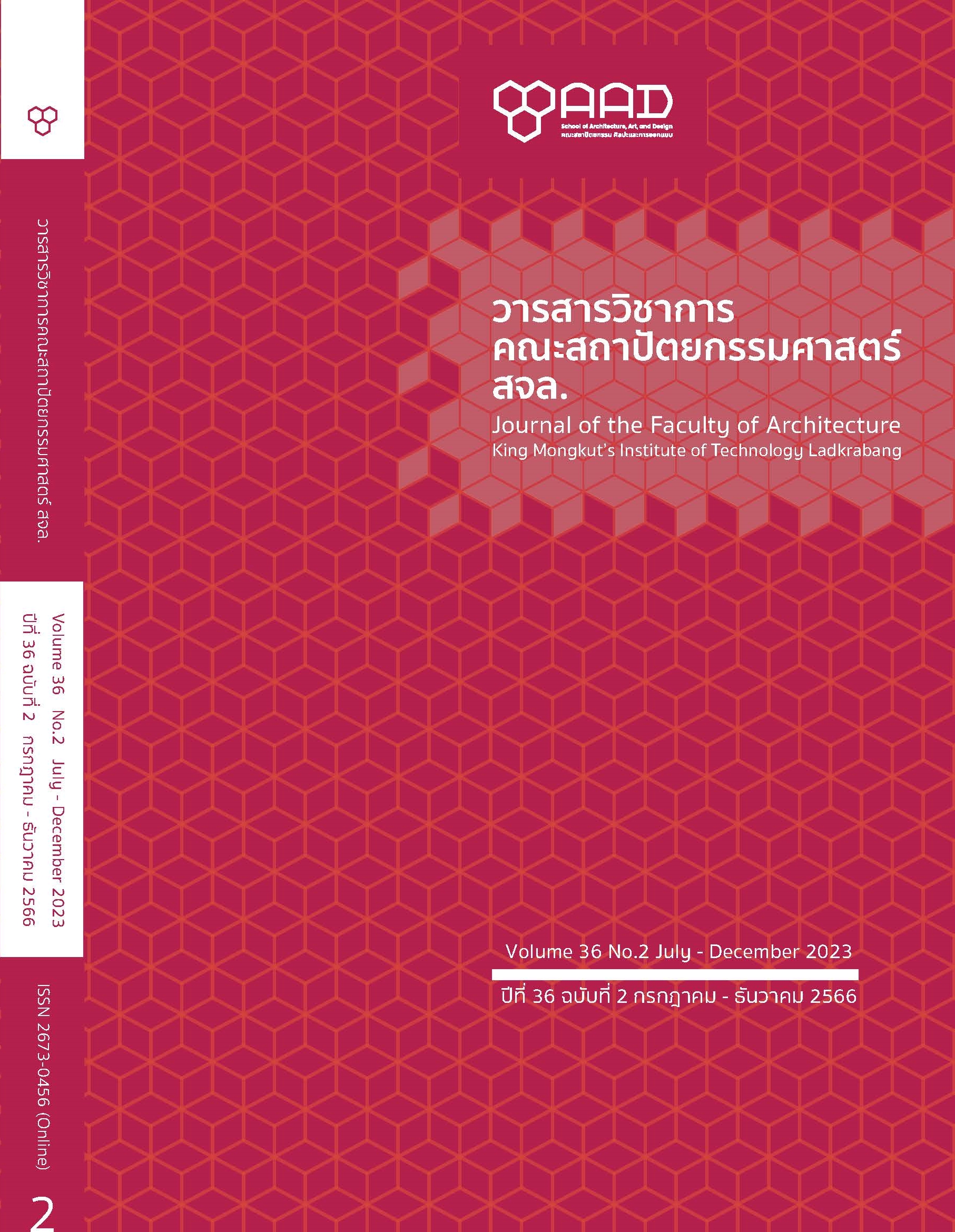Guidelines for Design Public Space for New Normal case study Public Space Phayao Lake
Main Article Content
Abstract
The objective of this research was to identify guidelines for designing public space for the new normal under a case study of Phayao Lake surrounding public space, covering an area of 17,800 square meters. In addition to examining the physical environment and existing usage patterns, the study also examined local user behaviors, needs, and benefits. Finally, design concepts for public spaces that were shaped by the new normal way of life were examined and compiled for the design process. Current environmental photographs and aerial photographs were used as the research instruments. A randomized sample of 300 users was surveyed regarding their usage needs and benefits, and the behavior of users was recorded using a behavior recording method with 100 samples. The findings indicated that there was no traffic system and a spacious, open area in the current condition. There were spaces designated for group sporting activities, and select areas included exercise equipment. People in the region used it as a place to unwind and work out using equipment. The analysis of user requirements revealed that users wanted a beautiful environment, a traffic system for exercising walking and jogging, and spaces designed for relaxation. Multiple access points and a flexible space design were summarized as the new standard for public space architecture. There should be a one-way path with wider walking distances as part of the area's internal traffic system. The single activity space should be accessible before the group activity area according to the design of the access points. There has to be more green spaces to establish connections between personal areas and natural setting. The space should be adaptable enough to accommodate different design choices. More spaces ought to be developed to support regional companies. The main entrance should be given priority in the space division design as the primary point of access for leisure and observation in a lone seated area. Group relaxation should take place in the second access area, individual exercise in the third access area, group exercise in the fourth access area, and team sports activities in the fifth access area. Links to recreation areas and green spaces should be present in every location.
Article Details

This work is licensed under a Creative Commons Attribution-NonCommercial-NoDerivatives 4.0 International License.
This work is licensed under a Creative Commons Attribution-NonCommercial-ShareAlike 4.0 International License.
Copyright Transfer Statement
The copyright of this article is transferred to Journal of The Faculty of Architecture King Mongkut's Institute of Technology Ladkrabang with effect if and when the article is accepted for publication. The copyright transfer covers the exclusive right to reproduce and distribute the article, including reprints, translations, photographic reproductions, electronic form (offline, online) or any other reproductions of similar nature.
The author warrants that this contribution is original and that he/she has full power to make this grant. The author signs for and accepts responsibility for releasing this material on behalf of any and all co-authors.
References
Chaijan, S., & Laiprakobsup, N. (2016). Public concepts of urban public space [doctoral dissertation]. Kasetsart University. (in Thai)
Chudasri, T. (2014). The concept for approoriatr public space to the behavior of the generation Y [Master dissertation]. Silpakorn University. (in Thai)
Chomchưrn, P. (2021). The spread of covid-19 and the use of public space and urbanization. The Office of the council of State of Thailand. (in Thai)
Department of local administration Thailand. (2023). Standards for recreational facilities. https://www.dla.go.th/work/e_book/eb1/stan18/18.htm (in Thai)
Gubić, I, & Wolff, M. (2022). Use and design of public green spaces in Serbian cities during the covid-19 pandemic. Habitat International, 128(102651), 1-9. https://doi.org/10.1016/j.habitatint.2022.102651
Guo X., Tu X., Huang G., Fang X., Kong L., Wu J. (2022). Urban greenspace helps ameliorate people's negative sentiments during the COVID-19 pandemic: The case of Beijing, Building and Environment, 223(109449), 1-12. https://doi.org/10.1016/j.buildenv.2022.109449
Honey-Rosés, J., Anguelovski, I., Chireh, V. K., Daher, C., Konijnendijk van den Bosch, C., Litt, J. S., … Nieuwenhuijsen, M. J. (2021). The impact of COVID-19 on public space: an early review of the emerging questions – design, perceptions and inequities. Cities & Health, 5(sup1), S263–S279. https://doi.org/10.1080/23748834.2020.1780074
Horayangkura, V. (2015). Architectural programming for the creation of built environment. Bangkok.
Horayangkura, V. (2013). Environmental psychology: a basis for creation and management of livable environment. Bangkok.
Khateeb, S. E., & Shawket, I. M. (2022). A new perception; Generating well-being urban public spaces after the era of pandemics, Developments in the Built Environment, 9(2022), 1-9. https://doi.org/10.1016/j.dibe.2021.100065
Meng, L., & Wen, K. H. (2023) An overview and trend analysis of research on the relationship between urban streets and residents' health in China pre- and post COVID-19 pandemic. Front. Public Health 11(1126656). https://doi.org/10.3389/fpubh.2023.1126656
Sepe M. (2021). Covid-19 pandemic and public spaces: Improving quality and flexibility for healthier places. Urban Des Int, 26(2), 159–73. https://doi.org/10.1057/s41289-021-00153-x
Somsuk, P. (1994). Locational analysis of an open space for recreation in the Chiang Mai municipal area [Master dissertation]. Chiang Mai University. (in Thai)
Sukkan, M., & Kimnuan, P. (2021). The activities and physical factors of public space in Nakhon Si Thammarat Old Town. Journal of the Faculty of Architecture King Mongkut's Institute of Technology Ladkrabang, 32(1), 28-42. (in Thai)
Toommala, P., Naivinit, W., Warinsitdhikul, P., & Warinsitdhikul, C. (2021). The process of collecting Information on the needs and behavior of Warin Chamrap Municipality Park users with Information technology to be used to determine the design guidelines. academic conference Ubon Ratchathani University, Thailand. (in Thai)
Ruki, U. A., & Wulandari, A. A. A. (2021). Post covid-19 public space adaption: a case study of building entrances in Jakarta. IOP Conf. Series: Earth and Environmental Science, 794(012243), 1-9. https://doi.org/10.1088/1755-1315/794/1/012243
Yamane, T. (1973). Statistics: an introductory analysis. Harper & Row.


